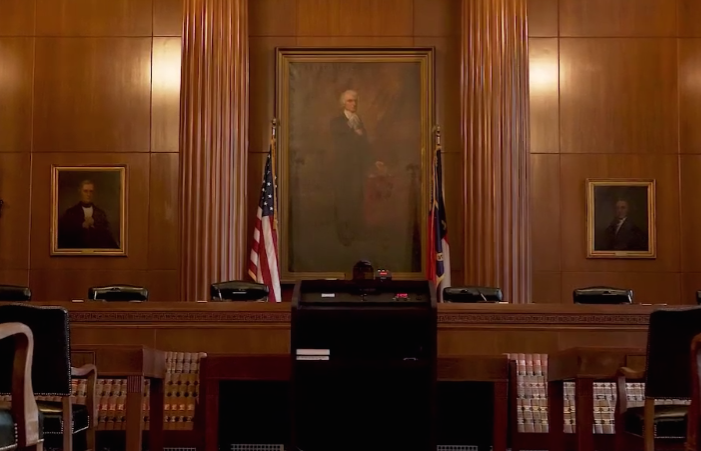N.C. commission grapples with giant courthouse portrait of slave-owning judge

A portrait of Chief Justice Thomas Ruffin (center), a slaveholder and defender of slavery, occupies a prominent place in the North Carolina Supreme Court. (Image is from a UNC-TV documentary on the court.)
Civil rights leaders and academics have long called for the removal of a large portrait of former Chief Justice Thomas Ruffin that hangs directly behind the bench of the North Carolina Supreme Court. Ruffin trafficked in human beings, he beat and raped an enslaved person named Bridget Murphey, and his rulings on behalf of the court sanctioned brutality by other enslavers. In an infamous 1829 decision, he wrote that "the power of the master must be absolute to render the submission of the slave perfect."
This week, a commission appointed by the North Carolina Supreme Court recommended that the painting be replaced with a smaller portrait of Ruffin. But three of the 15 members — including prominent racial justice activist Bree Newsome Bass, who in 2015 climbed a flagpole on the South Carolina statehouse grounds to remove a Confederate flag — disagreed with the decision.
The commission, which includes former high court justices, suggested that the court commission a new painting of Ruffin that isn't larger than the other justices' portraits that hang in the courtroom. It also suggested that the new, smaller portrait be moved to the side and the high court's seal be placed instead in the central spot, where Ruffin's large portrait now hangs.
Newsome Bass voiced her opposition to hanging any portrait of Ruffin and instead called for removing all portraits from the courtroom. Her statement was signed by two other commissioners, Lyniese Williams and Darin Waters, and described the historical context in which the tradition of displaying justices' portraits began.
"The original purpose of hanging the portraits in 1888 was to venerate three particular justices who were significant to the Confederacy," the statement noted, referring to Ruffin and Justices Thomas Samuel Ashe and Edwin Reade.
Sally Greene, an attorney and Orange County commissioner who has publicly called for Ruffin's portrait to come down, said in an interview with Facing South that she agrees with Newsome Bass. "Since courtrooms should be neutral spaces where blind justice is administered, any portrait challenges that neutrality," she said. Greene noted that the high courts of Alabama, Georgia, and South Carolina don't display portraits in their courtrooms.
Until six months ago, a life-sized statue of Ruffin greeted people entering the North Carolina Court of Appeals. When protests over police brutality and racial injustice erupted on the streets of Raleigh this summer, protesters broke windows near a gate that was just a few feet from the statue, which was removed several weeks later.
Across the street from the high court, several monuments to Confederate soldiers were removed from the grounds of the former state capitol, which now serves as offices for the governor and his staff. Dozens of Confederate monuments in North Carolina have been removed by authorities or torn down by protesters in recent years. Similar statues glorifying the slavocracy have come down around the South.
Earlier this year, a descendant of Ruffin and Murphey, Leslie Jackson, called on the courts to remove Ruffin's portrait. "He was a monster," she told Facing South.
The commission to address the Ruffin portrait was established in 2018, but it had no members until appointments last year by Chief Justice Cheri Beasley, who just lost her seat to a Republican challenger, fellow Justice Paul Newby.
Williams, a professor of art history at UNC-Chapel Hill, said that an alternative recommendation to hang the new smaller Ruffin portrait in a less prominent position lost by one vote. Newsome Bass argued that if the portraits remain in the courtroom, questions about Ruffin will keep coming up in the future.
Newsome Bass and Williams emphasized that courts should try to ensure that all parties feel like they're getting an impartial hearing. Newsome Bass said the North Carolina Supreme Court "should strive with every effort to maintain a position of neutrality and a commitment to the concept of blind justice," which is symbolized in the image of Lady Justice on the court's seal.
The high court could soon act on the commission's recommendations. In January, a new court will convene with a smaller Democratic majority, after the GOP swept appellate court elections this year.
In her own dissenting statement, Williams pleaded with the court. Knowing that people could enter the courtroom and "believe the portraits that hang there communicate a prejudiced space," she asked, "what will you do?"
Tags
Billy Corriher
Billy is a contributing writer with Facing South who specializes in judicial selection, voting rights, and the courts in North Carolina.
